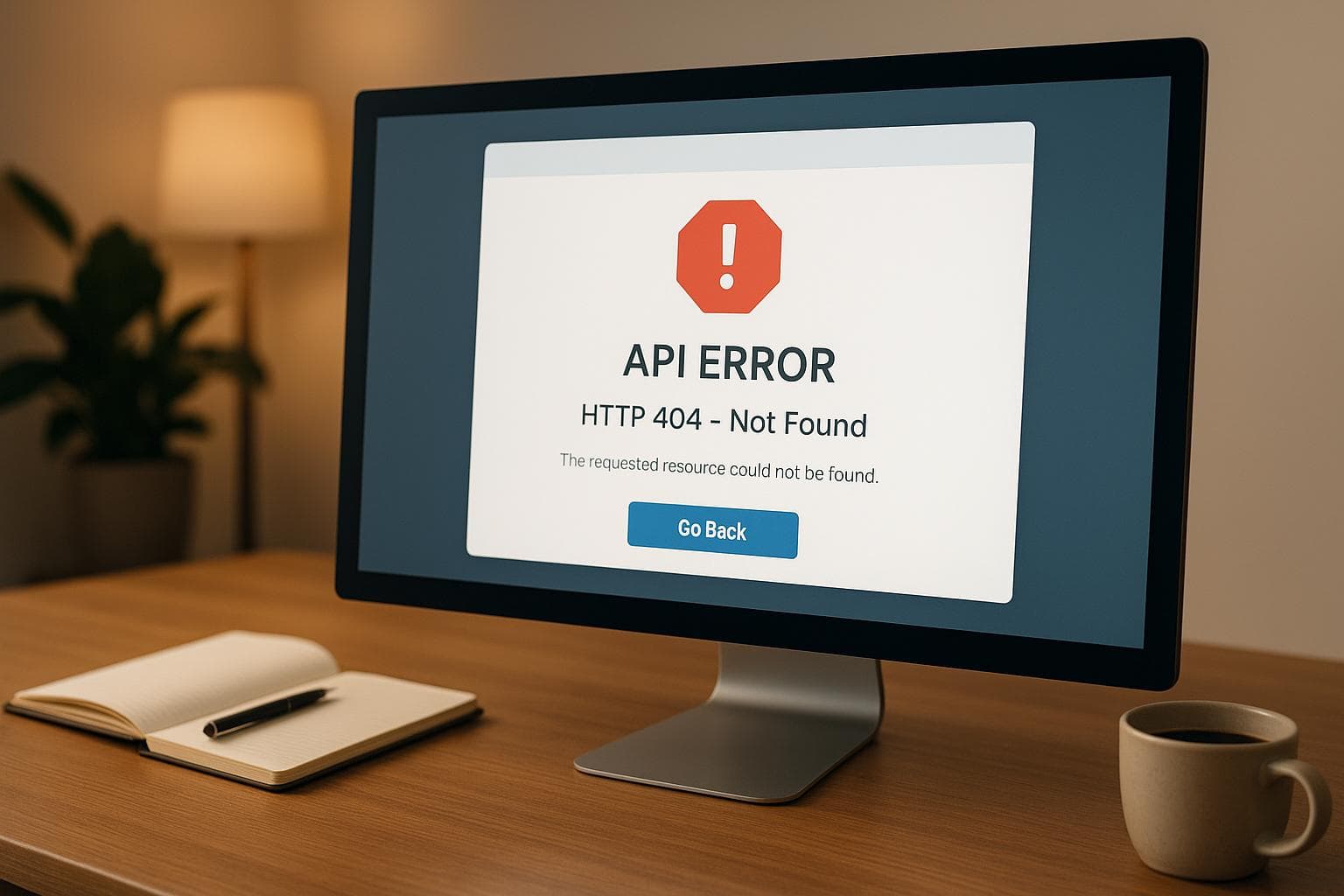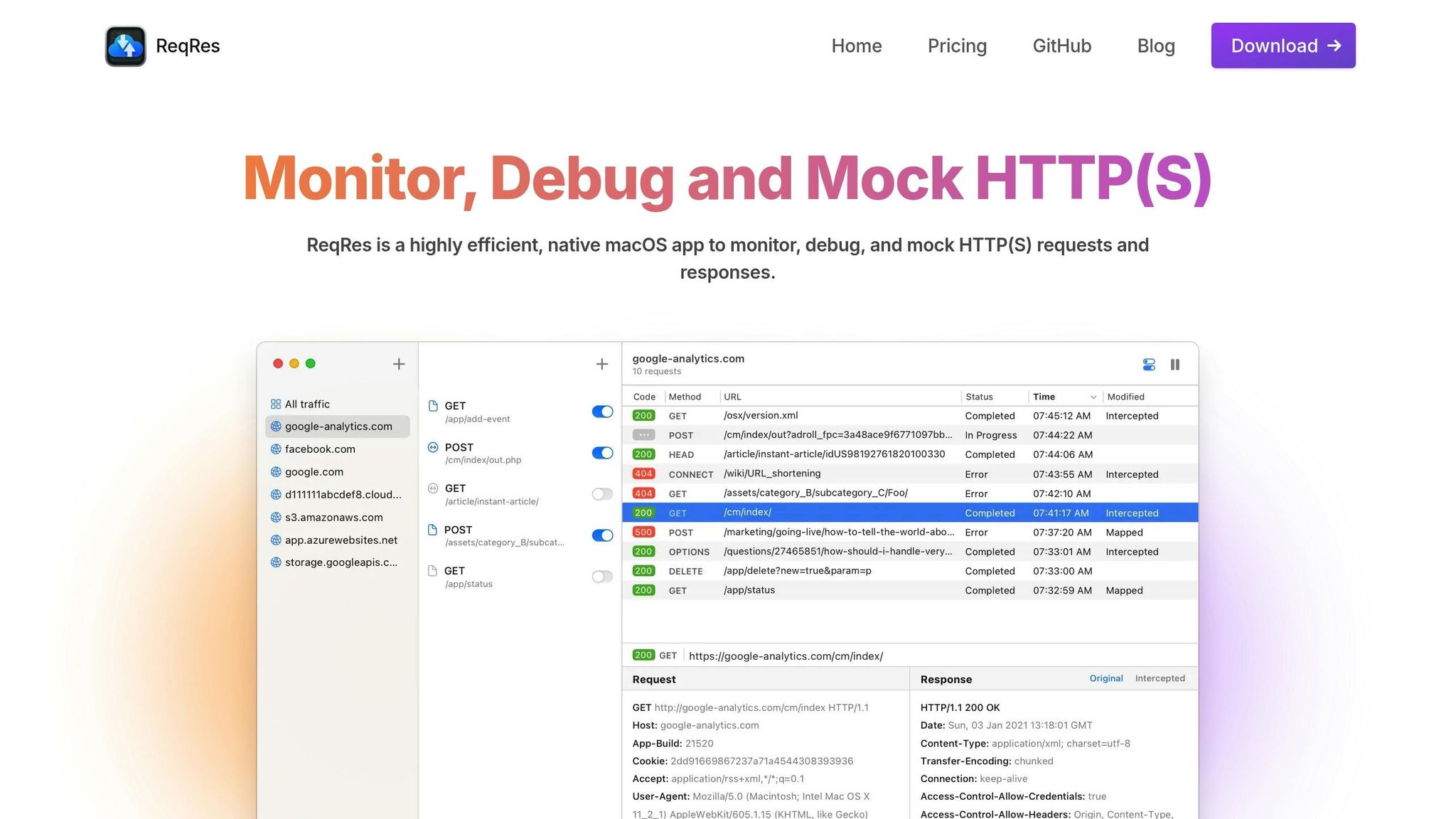
HTTP Error Handling Checklist for APIs
Handling HTTP errors effectively is essential for building reliable APIs. Clear error messages, consistent response formats, and proper HTTP status codes make debugging easier and improve user experience. Here's a quick summary of best practices:
-
Use Proper HTTP Status Codes:
- 4xx for client-side issues (e.g., 400 for bad requests, 401 for authentication errors).
- 5xx for server-side problems (e.g., 500 for internal errors, 503 for service downtime).
-
Standardize Error Responses:
Use consistent JSON structures like:{ "error": { "code": "INVALID_CREDENTIALS", "message": "The provided API key is invalid or expired", "details": { "timestamp": "2025-05-02T14:30:00Z", "requestId": "req_abc123" } } } -
Write Clear Error Messages:
Be precise, add context (e.g., timestamps, request IDs), and suggest solutions. -
Test Error Scenarios:
Validate error handling for authentication, input validation, rate limits, and system failures using tools like ReqRes to mock responses and simulate edge cases. -
Monitor and Improve:
Analyze recurring errors, update documentation, and ensure fast response times.
Core Error Handling Guidelines
Handle errors with clarity, consistency, and security. Below, you'll find key practices for managing API errors effectively, covering status codes, response formats, and error messages.
HTTP Status Code Best Practices
Choosing the right HTTP status codes is essential for clear communication. Stick to these conventions:
| Status Code Range | Purpose | Examples |
|---|---|---|
| 400-499 | Client-side issues | 400 (Bad Request), 401 (Unauthorized), 403 (Forbidden), 404 (Not Found) |
| 500-599 | Server-side issues | 500 (Internal Server Error), 502 (Bad Gateway), 503 (Service Unavailable) |
Use specific codes to communicate issues clearly. For example, return 401 for authentication failures and 503 to indicate maintenance periods.
Standard Error Response Format
Maintain a consistent JSON structure for error responses:
{
"error": {
"code": "INVALID_CREDENTIALS",
"message": "The provided API key is invalid or expired",
"details": {
"timestamp": "2025-05-02T14:30:00Z",
"requestId": "req_abc123"
}
}
}
This format includes key details while safeguarding sensitive system information. The details object can provide helpful debugging context, such as timestamps and request IDs, without exposing internal mechanisms.
Writing Clear Error Messages
- Be precise: Replace vague messages like "Authentication failed" with specifics such as "Invalid authentication token format."
- Add context: Include details like request IDs and timestamps to help pinpoint issues.
- Offer solutions: Instead of "Access denied", suggest actions like "Check API key permissions or generate a new key."
Testing error responses with tools like ReqRes can ensure your messages are clear and effective, while also monitoring API behavior in real time.
Error Scenario Testing
Thoroughly test API error responses across various failure scenarios to ensure reliability.
Input and Auth Error Tests
Focus on common issues related to input validation and authentication:
| Test Category | Test Cases | Expected Response |
|---|---|---|
| Authentication | Invalid API keys, expired tokens | 401 with detailed token status |
| Authorization | Insufficient permissions, role conflicts | 403 with required access level |
| Input Validation | Malformed JSON, invalid data types | 400 with field-specific errors |
Use consistent test data to maintain accuracy and reliability. Afterward, move on to broader system failure scenarios.
System Failure Tests
Leverage ReqRes's mocking tools to simulate:
- Response delays to test how clients handle timeouts
- Rate limiting scenarios
- Failures in service dependencies
- Network disruptions
ReqRes's Map Local Tool allows you to map specific requests to pre-configured error responses stored locally. This setup streamlines testing different failure modes without altering server configurations.
Once systemic failures are covered, dive into extreme conditions to test API limits.
Edge Case Testing
1. Payload Size Limits
Check API behavior for requests at or beyond size constraints:
- Maximum allowed payload sizes
- Minimum valid request bodies
- Empty or null values in required fields
2. Concurrent Request Handling
Examine error responses under heavy load conditions:
- Multiple authentication attempts at the same time
- Parallel requests to endpoints with rate limits
- Failures in batch operations
3. Recovery Scenarios
Evaluate recovery paths using ReqRes:
- Switching to backup systems during failures
- Addressing cache invalidation issues
- Restoring sessions after timeouts
ReqRes's local file mapping feature simplifies edge case testing. It enables developers to quickly toggle between error scenarios without changing server-side configurations.
Error Handling Maintenance
Ensure your API remains reliable by consistently monitoring and improving error handling processes.
Error Pattern Analysis
Identify and address recurring error trends using tools like ReqRes. Focus on these critical areas:
| Analysis Area | Key Metrics | Action Items |
|---|---|---|
| Frequency | Number of occurrences | Address frequently occurring errors first |
| Impact | Affected users/systems | Tackle issues with the greatest impact |
| Response Time | Time to detect errors | Investigate endpoints with slow detection |
| Resolution Rate | Time to resolve errors | Simplify and speed up resolution processes |
ReqRes's intercepting tools can gather detailed error data, helping you spot trends. Once patterns are identified, ensure your documentation reflects these findings.
Documentation Updates
Keep error documentation current and accurate. Use ReqRes's plain text display to validate error responses against your documentation. Focus on the following:
- Response Format Verification: Ensure actual error responses align with documented formats.
- Message Clarity Check: Confirm error messages are clear and actionable.
- Status Code Alignment: Verify HTTP status codes correspond to actual API behavior.
The Map Local Tool in ReqRes allows for quick testing of error scenarios without altering the server, making it easier to validate documentation updates.
Error Response Time
After updating documentation, shift your attention to improving response times. ReqRes's monitoring features can help track performance across various error scenarios. Key areas to consider:
| Response Time Aspect | Considerations | Optimization Approach |
|---|---|---|
| Error Detection | Promptly identify issues | Monitor latency using ReqRes |
| Response Generation | Quickly process errors | Enhance server processing efficiency |
| Client Delivery | Reduce delays for users | Test responses under different latency conditions |
With ReqRes, you can:
- Simulate response scenarios to test client behavior
- Verify timeout handling mechanisms
- Build a local library of common error responses for quicker testing and resolution
These steps ensure your API remains robust and user-focused, even in challenging situations.
Error Testing with ReqRes

This section delves into how ReqRes can be utilized for effective error testing, building on the strategies mentioned earlier.
Live Traffic Monitoring
ReqRes enables real-time monitoring by acting as a man-in-the-middle, logging HTTP(S) traffic between client applications and servers. It displays HTTP traffic in plain text, making it easier to identify issues.
| Monitoring Feature | Testing Capability | Implementation Benefit |
|---|---|---|
| Real-time Interception | Detect errors immediately | Identify issues as they happen |
| Plain Text Display | Validate responses quickly | Speeds up debugging |
| SSL Traffic Support | Test secure endpoints | Covers HTTPS testing completely |
| One-click Setup | Fast implementation | Requires minimal configuration |
Error Response Mocking
ReqRes allows you to mock error responses without changing server code. Using the Map Local Tool, you can define specific error scenarios to test how your client handles various conditions and status codes.
This tool is especially useful for testing rare edge cases that are hard to replicate in a live environment. By creating a library of error responses, you can quickly switch between scenarios, ensuring your error handling mechanisms are reliable.
Quick Test Setup
ReqRes's macOS interface simplifies error testing with a straightforward process:
- Configure Interception Rules: Set rules to capture specific endpoints or domains for instant error visibility.
- Create Mock Responses: Develop error response files tailored to different testing needs, such as:
- Client Errors: For verifying input handling.
- Security Errors: To check access control measures.
- Server Errors: For evaluating system resilience.
- Map Response Files: Use the Map Local Tool to assign your custom response files to specific endpoints.
These methods integrate smoothly with the error handling practices discussed earlier, offering a streamlined approach to testing.
Summary
Handling HTTP errors effectively is key to building reliable APIs. This checklist highlights important practices, such as using proper HTTP status codes and testing error scenarios thoroughly, to ensure a systematic approach to error management.
A strong error-handling system relies on three main components:
| Component | Purpose | Benefit |
|---|---|---|
| Status Code Implementation | Classifies errors accurately | Speeds up debugging and troubleshooting |
| Standardized Response Format | Ensures consistent communication | Simplifies client integration |
| Clear Error Messages | Provides actionable feedback | Improves developer experience |
These elements are critical for conducting detailed error scenario tests.
Comprehensive error testing is a must. Tools like ReqRes simplify this process by offering real-time traffic monitoring and error response mocking. The Map Local Tool allows quick testing of edge cases without altering server-side code.
To maintain effective error handling, focus on:
- Pattern Analysis: Monitor live traffic to spot recurring issues.
- Documentation Updates: Keep error response guidelines up-to-date.
- Response Time: Ensure error responses are timely and meet performance benchmarks.
ReqRes enhances visibility into HTTP(S) traffic and supports error scenario testing, enabling developers to identify and fix issues before they affect users.
A consistent and clear error-handling system builds a dependable foundation that developers can work with and debug efficiently.
FAQs
How can I make my API's error messages more helpful for debugging?
To create more helpful error messages for debugging, ensure they include clear descriptions of the issue, relevant error codes, and actionable suggestions. Providing detailed context, such as the endpoint, request parameters, and expected versus actual behavior, can significantly improve troubleshooting.
Using a tool like ReqRes, you can monitor and debug your API's HTTP(S) traffic in real time. This allows you to intercept and analyze requests and responses to identify where errors occur and refine your error messages for clarity and usefulness.
What are common mistakes to avoid when selecting HTTP status codes for API error handling?
When choosing HTTP status codes for API error handling, it's important to avoid a few common mistakes to ensure clarity and proper communication with clients:
-
Using generic codes excessively: Avoid relying too heavily on generic codes like
500(Internal Server Error) for all server-side issues. Instead, use more specific codes, such as503(Service Unavailable) or502(Bad Gateway), to provide clearer context. -
Misusing client error codes: Ensure you use
4xxcodes correctly. For example,400(Bad Request) should be used for malformed requests, while401(Unauthorized) and403(Forbidden) have distinct meanings related to authentication and permissions. - Ignoring detailed feedback: Pair status codes with meaningful error messages in the response body. This helps developers understand what went wrong and how to fix it.
By carefully selecting status codes and providing detailed responses, you can improve debugging efficiency and enhance the developer experience.
How can ReqRes help test API error scenarios and improve reliability?
ReqRes is a macOS application that simplifies testing and debugging of API error scenarios. By allowing you to intercept HTTP(S) requests and responses, mock endpoints, and use local files as responses, it helps you simulate a wide range of conditions efficiently.
With ReqRes, you can test edge cases, validate error handling, and ensure your API performs reliably under various scenarios. This streamlined approach saves time during development and enhances the overall robustness of your API.